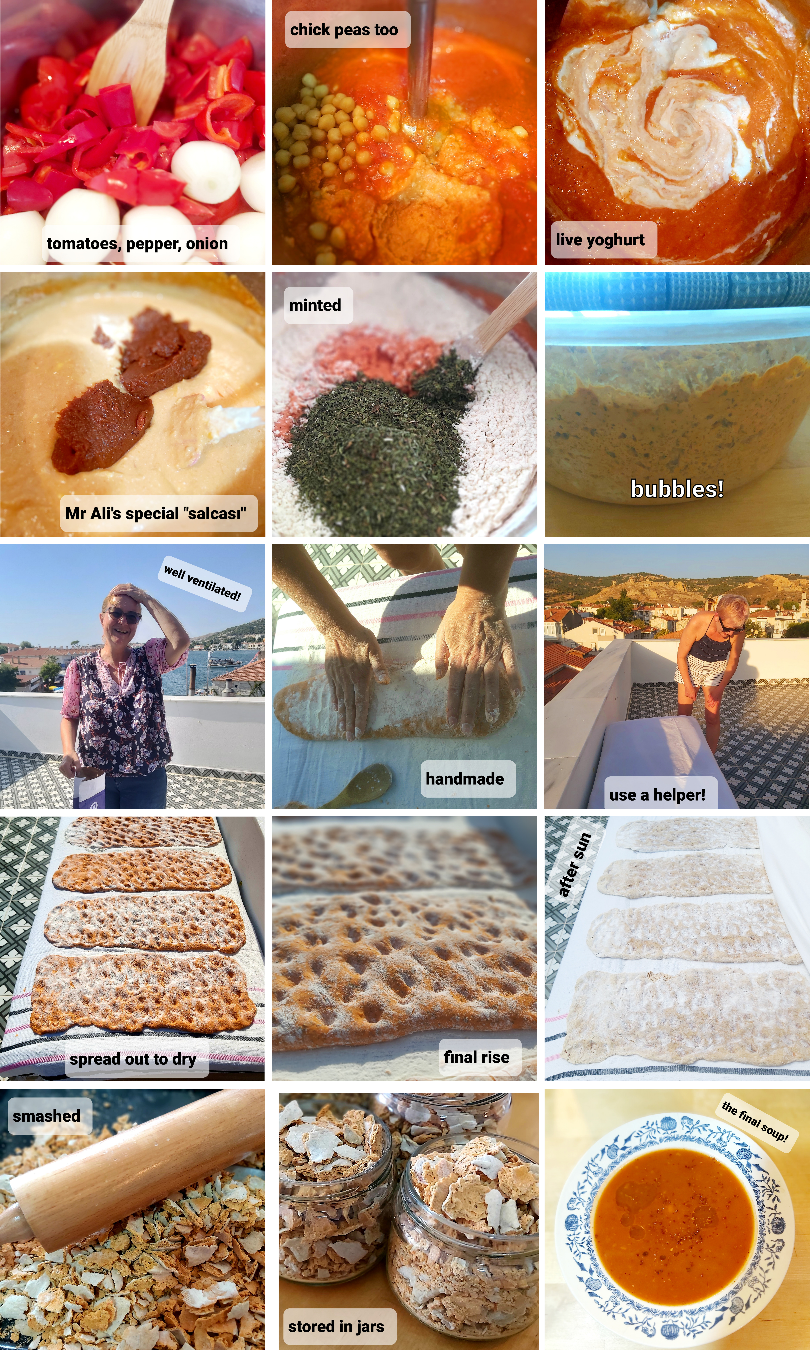Possibly the world’s most ancient convenience food, this is preserving genius, relying on fermentation, patience, sunshine and nothing else. Take the bounty of summer (tomatoes, peppers, onions and herbs), ferment with yoghurt, flour and herbs and dry it in the sun. Smash it into granules and store in a dry place until you want to bring it back to life.
Come winter all you need to do is rehydrate your tarhana and all those cultures spring back to life dessert flower like. Add some tomato/pepper concentrated puree (“salcası”), a bit of garlic and some stock and you have a pretty instant, extremely nutritious and very satisfying “tarhana soup“.
In fact this art of culinary resurrection has cousins in southern Romania where traditionally bagel type rings of sourdough (“tarate”) were threaded on sticks and dried in the baking sun. To make fresh bread they were rehydrated and mixed with more flour and water whereupon the yeasts sprang back to life and the bread literally “rose from the dead”.
While in Turkey Tarhana is mainly associated with a winter soup base, it is also produced as a wafer, generally a plainer yoghurt and flour affair and eaten like potato chip snacks, particularly from Maraş region in SE Turkey.
While the sun-drying does not cook the flour the fermentation I think has an effect on the digestibility – certainly while not a scientific trial, I have nibbled a fair few pieces of my tarhana “rubble” and the taste is tangy and moreish and no taste of raw flour at all.
There are of course almost as many family recipes and intriguing regional variations as there are Turks! Sour tarhana made with wild plums from the Mediterranean or an Aegean one with mastic gum (“Sakız”) , cinnamon and clove for example deserve further investigation.
What I love is the thought of bazillions of beneficial bacteria, doing their fermenting thing and then being put to sleep by the drying process only to be resurrected with a bit of water and ready to bestow all their goodness and tangy taste, into fullsome food. Miraculous indeed.
There is nothing particularly difficult about making tarhana and the ingredients are not exotic the only difficult thing perhaps in our accelerated lives is setting aside 8-12 days in a row where you can tend to it every day.
Ingredients
For a moderate ( by Turkish standards!) 8-10 jars of “tarhana rubble”:
- 500g onions, peeked and roughly sliced
- 500g red peppers, deseeded and roughly chopped
- 500g tomatoes, roughly chopped
- 500g live yoghurt
- 250g cooked chickpeas (use any excess to make some hummus)
- A generous amount of dried mint – 70g or so
- 3 tablespoons of rock salt (just as in pickling iodised salt is a no no)
- Organic white flour 2-3kgs
- 1 teaspoon of sourdough starter granules (optional)
Equipment
A large bowl for the dough mixture. Tea towels. A stick blender or food processor.
For sundrying outdoors: a wooden table, well ventilated and linen cloths (old sheets work well) covered with flour.
For oven drying: a fan assisted oven set at 50-60C , trays lined with greaseproof paper, racks
How To
Day 1: Lightly poach all the vegetables in a saucepan barely covering them with water. Reserve the liquid, soak the chickpeas overnight in the liquid. Refrigerate the cooked veggies.
Day 2: Cook the chickpeas until soft. Puree the vegetables. Add the cooked chickpeas and puree again. I use a stick blender.
Pour the puree into a large (10litre) bowl( One that you might use for a large amount of bread dough. ) Add the yoghurt and salt and mint. Mix well.
Add flour until you have a loose dough. If yoy have made sourdough bread then you know the kind of consistency.
Add the teaspoon of sourdough starter granules
Cover with a damp teatowel and leave to ferment at room temperature overnight
Days 3-7 Feed the dough every day with more flour to maintain the same texture. Keep in the refrigerator for a slow ferment which deepens the flavour. Check the bubbles and how it tastes and smells – it should smell pleasingly “beery” and start to taste tangy.
Day 8 Depending on how wet your dough is (and how windy your drying area is!) Either drop the dough pancake-batter-style on to the floured cloth or make heavier flat ciabatta style “loaves” as I have done, with finger indents to increase the surface area and help drying.
I covered mine with an old sheet at nightime just to prevent marauding stray cats or flocks of doves and pigeons from tucking in!
If its lively the dough will rise again in the sun before the high heat stops the yeast in their tracks and the wind and the warm air harden the dough. I rather like that my tarhana is aerated. The surface bleaches in the sun which creates an attractive two-tone effect in the shards with a terracotta inside and white outside.
Day 9-10-11 turn your dried dough over. Depending on the sun and wind the dough may dry faster or slower. If it is still a bit moist (the insude still pliable) don’t be afraid to finish off in the oven.
Day 12 smash the brittle dough into small pieces usung a rolling pin and a strong plastic bag or cloth shopping bag. I prefer this as I think it looks pretty and truly handmade. Alternatively pulse in a blender to obtain a powder.
Place in bone dry jars (i warm mine in the oven to be sure) and fill. If you have the traditional cotton sacks, use those.
Use to make the traditional tarhana soup or add to some sourdough for a deeper flavoured loaf.


